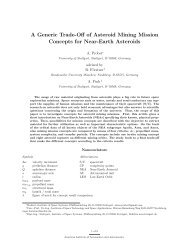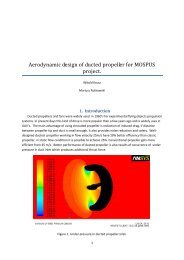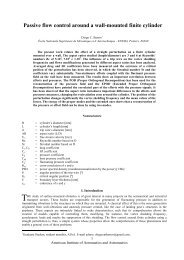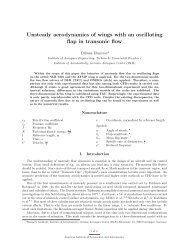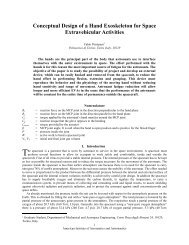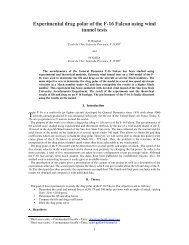Preparation of Papers for AIAA Technical Conferences - Pegasus
Preparation of Papers for AIAA Technical Conferences - Pegasus
Preparation of Papers for AIAA Technical Conferences - Pegasus
You also want an ePaper? Increase the reach of your titles
YUMPU automatically turns print PDFs into web optimized ePapers that Google loves.
Analysis <strong>of</strong> the Validation objectives <strong>of</strong> the TITAN Concept<br />
<strong>of</strong> Operations (Turnaround Integration in Trajectory And<br />
Network)<br />
Andrea Villa García 1<br />
Universidad Politécnica de Madrid- ETSIA,Madrid, Spain<br />
This paper details the TITAN Concept <strong>of</strong> Operations Validation objectives analysis.<br />
TITAN is an advanced turnaround Operational Concept per<strong>for</strong>med as an integral part <strong>of</strong><br />
the aircraft trajectory. It is based on the principles <strong>of</strong> Collaborative Decision Making (CDM)<br />
and System Wide In<strong>for</strong>mation Management (SWIM). The TITAN validation approach was<br />
based on the application <strong>of</strong> the European Operational Concept Validation Methodology(E-<br />
OCVM). The Validation objectives assessment was per<strong>for</strong>med through the analysis <strong>of</strong><br />
simulation results from a discrete event, extended network queuing simulation model.<br />
Conclusions obtained from the validation activities show that the TITAN Operational<br />
Concept is able to deliver the expected per<strong>for</strong>mances in terms <strong>of</strong> efficiency, predictability,<br />
flexibility and cost-effectiveness. This paper describes the process, the results and the<br />
analysis per<strong>for</strong>med in the validation.<br />
Nomenclature<br />
ACT = Actual Completion Time<br />
AIRS = Airport In<strong>for</strong>mation Report Service<br />
AOBT = Actual Off-Block Time<br />
ASRS = Aircraft Status Report Service<br />
AST = Actual Start Time<br />
ATM = Air Traffic Management<br />
ATTT = Actual Turnaround Time<br />
BFIS = Baggage Flow In<strong>for</strong>mation Service<br />
ECT = Estimated Completion Time<br />
E-OCVM = European Standard Methodology <strong>for</strong> Operational Concepts<br />
EST = Estimated Start Time<br />
ETTT = Estimated Turnaround Time<br />
KPA = Key Per<strong>for</strong>mance Area<br />
KPI = Key Per<strong>for</strong>mance Indicator<br />
OBT = Off-Block Time<br />
PCT = Planned Completion Time<br />
PFIS = Passenger Flow In<strong>for</strong>mation Service<br />
PST = Planned Start time<br />
SOBT = Scheduled Off-Block Time<br />
TITAN = Turnaround Integration in Trajectory And Network<br />
μ = mean value<br />
σ = standard deviation<br />
1 Graduate student, Airports and Air Navigation Systems Department. andrea.villa.garcia@alumnos.upm.es.<br />
1<br />
<strong>AIAA</strong>-<strong>Pegasus</strong> Student Conference
I. Introduction<br />
ALIDATION is an iterative process by which the fitness <strong>for</strong> purpose <strong>of</strong> a new system or operational concept<br />
V being developed is established. It can also be understood as the assessment <strong>of</strong> the candidate solutions against<br />
the requirements. Validation is a process composed by several parts including the analysis <strong>of</strong> the Validation<br />
objectives and the identification <strong>of</strong> conclusions.<br />
Turnaround delays cause approximately 4/5 <strong>of</strong> late departures flights 1 . As part <strong>of</strong> the project, TITAN* carried<br />
out an analysis <strong>of</strong> the current situation <strong>for</strong> the turnaround process and an identification <strong>of</strong> the stakeholder´s problems<br />
and needs 2 . Based on this in<strong>for</strong>mation, TITAN developed a new operational concept 3 <strong>for</strong> the turnaround as an<br />
integral part <strong>of</strong> the trajectory. TITAN considered the landside processes within the principles <strong>of</strong> Collaborative<br />
Decision Making 4 (CDM) and System Wide In<strong>for</strong>mation Management 5 (SWIM). The TITAN concept <strong>of</strong> operations<br />
also included new in<strong>for</strong>mation services -called TITAN In<strong>for</strong>mation Services- which provide in<strong>for</strong>mation about<br />
passengers or baggage location, aircraft status or airport resources. This new operational concept aimed to improve<br />
turnaround predictability, flexibility, efficiency and cost-effectiveness.<br />
Validation activities were necessary to assess these goals and to provide operational feedback (enhancements<br />
and corrections) <strong>for</strong> the refinement <strong>of</strong> the operational concept.<br />
The first TITAN validation phase was based on the application <strong>of</strong> the European Operational Concept Validation<br />
Methodology 6 (E-OCVM) and aimed to reach the V1 maturity level. During next phase -V2 phase- the feasibility <strong>of</strong><br />
the concept was established. This paper focuses on the analysis <strong>of</strong> the Validation objectives corresponding to the V2<br />
phase.<br />
V2 validation activities were based on simulation results from a discrete event, extended network queuing<br />
simulation model (TITAN Model) 7 . This s<strong>of</strong>tware model was developed by the TITAN Consortium. The TITAN<br />
Model allowed emulating the processes and resources involved in the turnaround <strong>of</strong> an aircraft within a realistic<br />
operational environment. Variation <strong>of</strong> the parameters ensured the validation <strong>of</strong> a wide operational context. In the<br />
course <strong>of</strong> the simulations, data was recorded to identify the per<strong>for</strong>mance parameters.<br />
The simulation output data was analyzed in detail to assess validation objectives and KPI. The Validation<br />
objectives assessment was based on comparing the results from a scenario where the TITAN Concept was<br />
implemented with a baseline scenario (a scenario that represented the current situation).<br />
Following sections describe TITAN Concept Validation objectives and KPI, output data from the simulations<br />
and their relationship with the Validation objectives and the analysis <strong>of</strong> the objectives. Finally, conclusions about<br />
this analysis are presented.<br />
II. Validation objectives description<br />
TITAN consortium defined the following Validation objectives <strong>for</strong> the V2 phase.<br />
Exercise Id<br />
V2-01<br />
V2-02<br />
V2-03<br />
V2-04<br />
Validation Objectives<br />
To assess whether the TITAN concept meets the targeted per<strong>for</strong>mances levels <strong>for</strong> predictability,<br />
efficiency and flexibility.<br />
To assess the influence <strong>of</strong> passenger and baggage processes, especially under several unexpected<br />
situations (e.g. late passenger arrival or lost baggage).<br />
To assess the effect <strong>of</strong> disruptions on the per<strong>for</strong>mances levels <strong>for</strong> predictability, efficiency and<br />
flexibility.<br />
To validate the application <strong>of</strong> the TITAN services described in the Operational Concept (BFIS,<br />
PFIS, AIRS, ASRS).<br />
To assess whether the TITAN concept meets the targeted per<strong>for</strong>mances levels <strong>for</strong> cost<br />
effectiveness.<br />
Table 1. V2 Validation Objectives<br />
To define each Validation objective, they were specified as exercise objectives. Exercises objectives represent<br />
lower level validation objectives. They describe the goal <strong>of</strong> the exercise and the specific scenario where the<br />
objective needs to be evaluated. Each exercise objective is achieved by simulating one or several Validation<br />
scenarios.<br />
*TITAN was a 7th Framework Programme co-financed by the European Commission. Private companies related to the ATM context, Air<br />
Navigation Services Providers, Research and Development Centers and Universities <strong>for</strong>med the TITAN Consortium. See www.titan-project.eu<br />
2<br />
<strong>AIAA</strong>-<strong>Pegasus</strong> Student Conference
A Validation scenario is a specific scenario developed <strong>for</strong> the purposes <strong>of</strong> undertaking validation activities and to<br />
gather evidence relevant to the validation objective. Validation scenarios were built using the TITAN Model<br />
description language. For validation activities, one generic scenario and four specific scenarios (Late passenger,<br />
Increasing demand, Late arrival and Lack <strong>of</strong> resources) were defined (see Table 2) . Each Validation scenario was<br />
repeated varying several numerical parameters. As a result, there were around 260 different scenarios.<br />
Normal<br />
Airport<br />
Operation<br />
Disruption<br />
Generic<br />
Scenario<br />
Late<br />
Passenger<br />
Specific Validation Scenarios<br />
Increasing<br />
demand<br />
Late<br />
arrival<br />
Lack <strong>of</strong><br />
resources<br />
Current situation GEN-1a SPEC-1a SPEC-2a SPEC-3a SPEC-4a<br />
TITAN concept GEN-1b SPEC-1b SPEC-2b SPEC-3b SPEC-4b<br />
Current situation GEN-2a SPEC-1c SPEC-2c SPEC-3c SPEC-4c<br />
TITAN concept GEN-2b SPEC-1d SPEC-2d SPEC-3d SPEC-4d<br />
Table 2.Validation scenarios<br />
For each exercise objective, it was necessary to identify the sub-processes* where the objective needed to be<br />
evaluated and an indicator. After that, a success criteria <strong>for</strong> each exercise objective was established. Table 3 shows<br />
an example <strong>of</strong> some <strong>of</strong> the exercise objectives.<br />
Exercise Objective<br />
V2.01-A. Check whether<br />
standard deviation <strong>of</strong> <strong>of</strong>fblock<br />
time (AOBT-<br />
SOBT) with TITAN is<br />
reduced to 3 minutes.<br />
V2.02-D. Check whether<br />
variability <strong>of</strong> processes<br />
durations decreases with<br />
TITAN with respect to<br />
Non TITAN.<br />
Baseline Scenario/<br />
Scenario to be<br />
evaluated<br />
GEN1AExe1/<br />
GEN1BExe1<br />
GEN2AExe5&8/<br />
GEN2BExe5&8<br />
Indicator Process Success Criteria<br />
Total Delay:<br />
ACT-PCT<br />
ACT-AST<br />
Variability <strong>of</strong> ETTT<br />
Standard deviation <strong>of</strong><br />
(ACT-AST) - (ECT-<br />
EST)<br />
Table 3.Exercise objectives<br />
Off-Block<br />
All turnaround subprocesses<br />
TITAN Standard<br />
deviation <strong>of</strong> the Off -<br />
Block delayed time <<br />
3 min.<br />
σ <strong>of</strong> the turnaround<br />
sub-processes duration<br />
with TITAN < σ <strong>of</strong><br />
the turnaround subprocesses<br />
duration<br />
non-TITAN<br />
To per<strong>for</strong>m the analysis and ensure the obtention <strong>of</strong> coherent and comparable results,TITAN developed a<br />
Per<strong>for</strong>mance Framework 8 that defined the Key Per<strong>for</strong>mance Indicators (KPI) . KPI identify what in<strong>for</strong>mation had to<br />
be obtained to reach the TITAN per<strong>for</strong>mance objectives. These indicators quantitatively described the per<strong>for</strong>mance<br />
<strong>of</strong> the turnaround process. Table 4 shows the identification <strong>of</strong> the measurements needed to calculate each metric <strong>for</strong><br />
some KPI.<br />
KPI Metric Calculation <strong>of</strong> Metric Measurement<br />
Variability <strong>of</strong> ETTT Time Standard deviation <strong>of</strong> ATTT-<br />
ETTT<br />
Off Block punctuality Percentage % <strong>of</strong> flights compliant with<br />
AOBT- SOBT 15 min<br />
*Turnaround sub-processes considered in validation scenarios were: Baggage loading, baggage unloading, boarding, catering check-in, cleaning,<br />
de-boarding, in-blocks, <strong>of</strong>f-blocks, passport (only <strong>for</strong> international turnaround), re-fueling and security<br />
3<br />
<strong>AIAA</strong>-<strong>Pegasus</strong> Student Conference
III. Description and reliability <strong>of</strong> simulation data<br />
TITAM Model produced a file containing all per<strong>for</strong>mance parameters <strong>for</strong> each simulation. According to the<br />
analysis <strong>of</strong> the measurements and the indicators necessary <strong>for</strong> validation purposes, datasets were selected <strong>for</strong> each<br />
sub-process:<br />
PST: Planned Start time, according to schedule input data and processes definition.<br />
EST: Estimated –by the TITAN Model- Start Time, according to schedule, planned and updated durations<br />
<strong>of</strong> the previous processes.<br />
AST: Actual Start Time, real start time <strong>of</strong> a process.<br />
PCT: Planned Completion Time.<br />
ECT: Estimated Completion Time.<br />
ACT: Actual Completion Time.<br />
Using these output data, following parameters were calculated to assess the exercise objectives:<br />
ACT-PCT: Delay <strong>of</strong> the process with regard to the schedule.<br />
ACT-ECT: Delay <strong>of</strong> the process with regard to the model estimation.<br />
ACT-AST: Real duration <strong>of</strong> the process.<br />
PCT-PST: Schedule duration <strong>of</strong> the process.<br />
(ACT-AST) – (PCT-PST): Difference between the real duration and the schedule one.<br />
Number <strong>of</strong> (ACT-PCT)>15min.<br />
To assess output data reliability a statistical analysis <strong>of</strong> output data was carried out. Statistical analysis was<br />
per<strong>for</strong>med over the measurements that served to assess the exercise objectives:<br />
ACT-PCT: Delay <strong>of</strong> the process with regard to the schedule.<br />
ACT-ECT: Delay <strong>of</strong> the process with regard to the model estimation.<br />
ACT-AST: Real duration <strong>of</strong> the process.<br />
(ACT-AST) – (PCT-PST): Difference between the real duration and the schedule one.<br />
Percentage <strong>of</strong> processes in which (ACT-PCT) >15min<br />
The statistical parameters obtained were:<br />
Mean <strong>of</strong> each measurement <strong>of</strong> every turnaround process: It served to know the central tendency <strong>of</strong> the<br />
process measurement (process delay or process duration average).<br />
Standard deviation (σ) <strong>of</strong> every turnaround process: It served to know the dispersion <strong>of</strong> the data<br />
measurement (dispersion <strong>of</strong> the processes delays or processes durations).<br />
Confidence interval (C.I.) <strong>of</strong> the <strong>of</strong>f block process delay: It served to ensure reliability <strong>of</strong> the data<br />
measurement by calculating the interval that contained an established percentage (Confidence level, α)<br />
<strong>of</strong> the data measurement.<br />
Each Simulation scenario was run until the output data allowed obtaining a confidence level <strong>of</strong> 0.95 <strong>for</strong> the <strong>of</strong>fblock<br />
process delay and a confidence interval <strong>of</strong> 0.33 minutes (20 seconds). That means that 95% <strong>of</strong> the flights had a<br />
delay in <strong>of</strong>f block process within the interval <strong>of</strong> ±20 seconds around the mean <strong>of</strong> the delays <strong>of</strong> all <strong>of</strong>f blockprocesses.<br />
Following tables show the statistical data obtained <strong>for</strong> each simulation run. Numeric values correspond to GEN-<br />
1a scenario.<br />
4<br />
<strong>AIAA</strong>-<strong>Pegasus</strong> Student Conference
Process<br />
ACT-PCT<br />
Average<br />
ACT-ECT<br />
Average<br />
ACT-AST<br />
Average<br />
(duration<br />
average)<br />
(ACT-AST)<br />
– (PCT-<br />
PST)<br />
Average<br />
(duration<br />
deviation<br />
average)<br />
Number <strong>of</strong><br />
processes in<br />
which<br />
(ACT-<br />
PCT)>15min<br />
Percentage<br />
<strong>of</strong> processes<br />
in wich<br />
(ACT-<br />
PCT)>15min<br />
Boarding 0,31 -1,94 21,80 -1,20 135 8 %<br />
Security -31,60 -30,84 88,40 -31,60 0 0 %<br />
Baggage Unloading -2,21 -3,67 10,64 -5,23 74 4 %<br />
Table 5.Calculated means <strong>for</strong> GEN-1a scenario.<br />
Process<br />
ACT-PCT<br />
Standard deviation<br />
ACT-ECT<br />
Standard deviation<br />
ACT-AST<br />
Standard deviation<br />
(duration standard<br />
deviation)<br />
(ACT-AST)–<br />
(PCT-PST)<br />
Standard deviation<br />
(duration deviation<br />
standard deviation)<br />
Boarding 10,52 10,00 7,66 7,66<br />
Security 6,38 7,85 6,38 6,38<br />
Baggage Unloading 8,62 5,62 2,42 3,04<br />
Table 6.Calculated standard deviation <strong>for</strong> GEN-1a scenario.<br />
Finally, the confidence interval was calculated according to the number <strong>of</strong> measurements. For the presented<br />
example (GEN1AExe1) five simulations were run (each simulation contains 339 flights), and there<strong>for</strong>e the results<br />
had 339*5=1695 measurements <strong>of</strong> the delay in <strong>of</strong>f-block. The average <strong>of</strong> the <strong>of</strong>f- block delay was 3,44 minutes,<br />
with a standard deviation <strong>of</strong> 8,09 minutes and a confidence interval <strong>of</strong> 23 seconds. In other words, <strong>of</strong>f -block delay<br />
<strong>of</strong> 95% <strong>of</strong> the flights was within the interval 3,44 ± 0,39 minutes (03:05 minutes, 03:50 minutes).<br />
All the samples analysed which take into account time (ACT-PCT, ACT-ECT...) vs. number/ percentage <strong>of</strong><br />
flights behaved as shown in Figure 1.<br />
Figure 1.Difference between ACT and PCT <strong>of</strong> <strong>of</strong>f-block sub-process<br />
Using statistical s<strong>of</strong>tware*, an analysis <strong>of</strong> the samples was per<strong>for</strong>med. The distribution that best fit the samples<br />
whose behaviour corresponds to the previous figure was the Burr distribution. The Burr distribution is a rightskewed<br />
distribution with a flexible shape and controllable scale and location. It is frequently considered as an<br />
alternative to a Normal distribution when the data shows slight positive skewness.Figure 2 represents the statistical<br />
analysis <strong>of</strong> the previous general sample. Variable x represents the difference between ACT and PCT <strong>of</strong> OBT<br />
(minutes) and f(x) is the probability density function corresponding to the Burr distribution.<br />
* Statistical s<strong>of</strong>tware used was EasyFit (http://www.mathwave.com/)<br />
5<br />
<strong>AIAA</strong>-<strong>Pegasus</strong> Student Conference
Figure 2.Burr distribution<br />
Exercise analysis was based on the comparison <strong>of</strong> the per<strong>for</strong>mances obtained in TITAN and non TITAN<br />
Simulation scenarios. In order to compare different simulation scenarios and indicators according to the validation<br />
objectives, it was necessary to choose one measure <strong>of</strong> central tendency (mean value, µ) and one measure <strong>of</strong><br />
dispersion (standard deviation, σ).<br />
IV. Results analysis<br />
A global overview <strong>of</strong> the results could be obtained from histograms which represented the <strong>of</strong>f-block delay<br />
per<strong>for</strong>med against the percentage <strong>of</strong> flights. Figure 3 shows an example <strong>of</strong> the histograms comparing TITAN and<br />
Non TITAN <strong>for</strong> two different scenarios; Scenarios “A” are Non TITAN scenarios and scenarios “B” are TITAN<br />
scenarios.<br />
Figure 3.TITAN and Non TITAN histograms<br />
TITAN simulations always got fewer delayed flights( in the exaplaxes showed, 2,5% <strong>of</strong> delayed flighs vs 11,4%<br />
<strong>for</strong> Normal Airport Operation scenario and 9% <strong>of</strong> delayed flights vs 15,2% <strong>for</strong> Lack <strong>of</strong> Resources scenario)<br />
A. Validation objectives criteria<br />
Each exercise objective was evaluated according to the criteria shown in Table 7.<br />
6<br />
<strong>AIAA</strong>-<strong>Pegasus</strong> Student Conference
Result<br />
Passed<br />
Passed with conditions<br />
Not passed<br />
Conditions<br />
Success criteria is fulfilled <strong>for</strong> all sub-processes<br />
Severity<br />
H (High)<br />
M (Medium)<br />
L (Low)<br />
If it affects at least Off-block.<br />
If it affects at least Boarding subprocess.<br />
If affects any other sub-process<br />
different from Boarding or Offblock.<br />
None <strong>of</strong> the sub-processes fulfill the success criteria<br />
Table 7.Success criteria<br />
Severity level “High” was assigned to <strong>of</strong>f-block sub-process because it is the last turnaround sub-process and it<br />
indicates if the flight is delayed. The boarding sub-process has a higher impact on <strong>of</strong>f-block delay than the rest <strong>of</strong><br />
sub-processes, thus severity level “Medium” was assigned to it.<br />
Each exercise objective was analyzed according to these criteria. Table 8 shows the analysis <strong>of</strong> one <strong>of</strong> the<br />
exercise objectives*.<br />
Exercise Objective V2-01.E<br />
Check whether number <strong>of</strong> delayed flights [(AOBT-SOBT)>15min] decreases by 9% with TITAN with respect to<br />
Non TITAN<br />
Simulation Scenario ID<br />
GEN1AExe1 (Non TITAN) // GEN1BExe1 (TITAN)<br />
Sub-process<br />
Offblock<br />
Measurement<br />
% <strong>of</strong> flights which :<br />
ACT OBT -PCT OBT >15 min<br />
Indicator<br />
% <strong>of</strong> delayed flights with TITAN < %<br />
delayed flights with non TITAN-9%<br />
Simulation Scenario ID % <strong>of</strong> delayed flights (delay>15 minutes) Is % <strong>of</strong> delayed flights with<br />
TITAN < % delayed flights<br />
with non TITAN-9%?<br />
GEN1AExe1 7,9 %<br />
GEN1BExe1 1,4 %<br />
<br />
Result<br />
Comments<br />
Passed Number <strong>of</strong> delayed flights more than 15 minutes is reduced by 82,2%.<br />
Table 8.V2-01.E Exercise objective analysis.<br />
*Full details are presented in WP3_DEL.3.3_Validation Report. See reference 9.<br />
7<br />
<strong>AIAA</strong>-<strong>Pegasus</strong> Student Conference
B. Validation objectives assessment<br />
1. Validation objective V2-01<br />
Exercise V2-01 assessed the efficiency, predictability and flexibility per<strong>for</strong>mances <strong>of</strong> the TITAN concept under<br />
normal airport operation. Four exercise objectives were passed, three were passed with conditions and two<br />
objectives were not passed. The global conclusion <strong>for</strong> Exercise V2-01 could be considered as reached with<br />
conditions.<br />
The first not passed objective entended to reduce the standard deviation <strong>of</strong> <strong>of</strong>f-block time to 3 minutes. Even<br />
though the objective was not reached, σ was reduced by 57,2% (standard deviation was reduced from 8,1 to<br />
3,5 minutes). The TITAN concept managed to reduce σ, although the initial objective was not reached.<br />
The second <strong>of</strong> the not passed objectives was focused on checking when efficiency and predictability<br />
per<strong>for</strong>mances were maintained under unexpected events. The objective was not reached because the<br />
TITAN model worked in a different way depending on the unexpected event when comparing TITAN<br />
scenarios. Efficiency and predictability per<strong>for</strong>mances were maintained according to the success criteria<br />
only when lost passenger or increasing demand scenarios were analyzed.<br />
Objectives related to reducing the percentage <strong>of</strong> delayed flights or sub-processes and turnaround duration<br />
were reached when comparing TITAN to non TITAN scenarios. Efficiency and predictability per<strong>for</strong>mances<br />
were maintained when an unexpected event occurred when comparing TITAN to non TITAN scenarios.<br />
Deviation between the estimated and actual end times <strong>of</strong> sub-processes was only reduced in boarding and<br />
<strong>of</strong>f-block processes when introducing the TITAN concept. However, the mean value <strong>for</strong> these objective<br />
measurements improved <strong>for</strong> almost all processes. Standard deviation <strong>for</strong> the <strong>of</strong>f-block process was reduced<br />
from 8 to 7,38 minutes.<br />
Deviation between the scheduled and actual duration time <strong>of</strong> sub-processes was not reduced <strong>for</strong> most<br />
processes due to decisions taken at TITAN decision points *. However, standard deviation <strong>for</strong> the <strong>of</strong>f-block<br />
remained unchanged. Variability <strong>of</strong> sub process duration was only reduced <strong>for</strong> the boarding sub-process<br />
from 7,66 to 6,08 minutes.<br />
2. Validation objective V2-02<br />
Exercise V2-02 dealt with the assessment <strong>of</strong> the impact on turnaround efficiency, predictability and flexibility<br />
per<strong>for</strong>mances <strong>of</strong> disruptions** in a TITAN environment. Five exercise objectives were passed, three were passed<br />
with conditions and two objectives were not passed. Exercise V2-02 could be considered as reached with conditions.<br />
The first not passed objective was based on reducing standard deviation <strong>of</strong> <strong>of</strong>f-block time to 3 minutes.<br />
Despite that the objective was not reached, standard deviation was reduced when different disruptions were<br />
analyzed.For re-fuelling disruption standard deviation was reduced from 11,5 to 6,09 minutes and <strong>for</strong><br />
baggage unloading disruption it was reduced from 10,39 to 6,51 minutes.<br />
The second not passed objective was focused on checking the isolated effect <strong>of</strong> a disruption in the TITAN<br />
concept when an unexpected event occurred. The global objective was not reached. However, standard<br />
deviation <strong>of</strong> the sub-processes duration with TITAN was maintained except <strong>for</strong> the in-block sub-process.<br />
The objective <strong>of</strong> maintaining average and standard deviation <strong>of</strong> the delay time sub-processes was only<br />
reached <strong>for</strong> some sub-processes when comparing TITAN scenarios. In-block values are maintained in all<br />
scenarios. Delay average and standard deviation <strong>for</strong> baggage loading, unloading and boarding sub-process<br />
were maintained only <strong>for</strong> Late arrival scenario.<br />
Objectives related to reducing the number <strong>of</strong> delayed flights or sub-processes and turnaround durations were<br />
reached when comparing TITAN to their corresponding non TITAN scenarios. Efficiency and<br />
predictability per<strong>for</strong>mances were maintained under unexpected events. The effect <strong>of</strong> an unexpected event<br />
on efficiency and predictability per<strong>for</strong>mances was maintained under success criteria comparing different<br />
TITAN scenarios.<br />
* During TITAN simulations, a set <strong>of</strong> common decisions were followed when an alert window appeared according with the<br />
in<strong>for</strong>mation provided by the TITAN Services.<br />
** A disruption is a <strong>for</strong>ced delay in one <strong>of</strong> the sub-processess.<br />
8<br />
<strong>AIAA</strong>-<strong>Pegasus</strong> Student Conference
The rest <strong>of</strong> the objectives were passed with conditions. The first one was focused on reducing deviation between<br />
the estimated and actual end time <strong>of</strong> sub-processes. Deviation between the estimated and actual end times <strong>of</strong><br />
processes increased <strong>for</strong> most sub-processes but <strong>of</strong>f-block standard deviation was reduced( from 9,90 to 9,36<br />
minutes).Mean values <strong>of</strong> the deviation between the estimated and actual end times <strong>of</strong> processes were reduced<br />
<strong>for</strong> most sub-processes. The second objective was focused on reducing the deviation between the scheduled and<br />
actual duration <strong>of</strong> sub-processes. Deviation between the scheduled and actual duration showed different<br />
behaviour <strong>for</strong> each sub-process. Mean value deviation only decreased <strong>for</strong> baggage unloading and boarding subprocesses.<br />
Variability <strong>of</strong> process duration was only reduced <strong>for</strong> the baggage unloading sub-process. The last<br />
objective was based on reducing the variability <strong>of</strong> sub-processes durations. The objective was only reached <strong>for</strong><br />
baggage unloading sub-process.<br />
3. Validation objective V2-03<br />
Exercise V2-03 aimed to validate the application <strong>of</strong> the TITAN In<strong>for</strong>mation Services (BFIS, PFIS, AIRS and<br />
ASRS). The Exercise V2-03 global objective could be considered as reached.<br />
Turnaround durations and variability decreased with TITAN with respect to non TITAN <strong>for</strong> all the situations<br />
analyzed. BFIS and PFIS resulted the most effective TITAN Services. Turnaround duration and its<br />
variability showed the lowest values when these services were implemented. Results applying AIRS and<br />
ASRS were better than Non TITAN results. However, there were no significant differences between them.<br />
Percentage <strong>of</strong> delayed flights decreased by using TITAN Services. Results using only BFIS and PFIS were<br />
quite similar to the ones obtained when all TITAN services were implemented. They provided a reduction<br />
<strong>of</strong> 94,6% <strong>of</strong> delayed flights. By applying only AIRS and ASRS, reduction <strong>of</strong> the percentage <strong>of</strong> delayed<br />
flights was 38,6%. Boarding and <strong>of</strong>f-block sub-processes showed more differences when different TITAN<br />
Services were implemented. For these processes, the delay mean value and standard deviation were greater<br />
when only AIRS and ASRS were implemented.<br />
There were not many differences between scenarios when comparing delayed time <strong>of</strong> sub-processes.<br />
Differences in boarding were due to the decisions taken during the TITAN simulation. Mean values <strong>of</strong> subprocesses<br />
duration were quite similar and standard deviation values were reduced when TITAN services<br />
were implemented( standard deviation was reduced from 7,22 to 5,46 min. <strong>for</strong> baggage loading and from<br />
15,27 to 6,01<strong>for</strong> boarding process when all TITAN Services are implemented) . Results were similar when<br />
all TITAN Services were implemented and when only some <strong>of</strong> TITAN Services were implemented.<br />
4. Validation objective V2-04<br />
Exercise objectives V2-04 dealt with assessing cost effectiveness. This exercise checked if certain level <strong>of</strong><br />
turnaround efficiency (assessed through delays) could be maintained under normal airport operation while reducing<br />
the number <strong>of</strong> resources. V2-04 objective compared two TITAN scenarios, one <strong>of</strong> them with a reduction <strong>of</strong> airport<br />
resources. The global objective V2-04 was not reached. It meant that TITAN Concept <strong>of</strong> Operations didn’t make up<br />
<strong>for</strong> resources reduction.<br />
Standard deviation <strong>of</strong> the turnaround sub-processes delay time with TITAN was not maintained <strong>for</strong> any process.<br />
The percentage <strong>of</strong> delayed flights was not maintained when reducing the number <strong>of</strong> resources by a 20%; it increased<br />
by 79,7%.<br />
C. KPI analysis<br />
Next table shows some <strong>of</strong> the KPI analyzed <strong>for</strong> V2-01 Validation objective. This analysis was done <strong>for</strong> all KPI<br />
<strong>of</strong> each Validation objective 9 .<br />
9<br />
<strong>AIAA</strong>-<strong>Pegasus</strong> Student Conference
Measurement //<br />
(unit)<br />
Non<br />
TITAN<br />
TITAN<br />
Non TITAN<br />
TITAN<br />
Non<br />
TITAN<br />
TITAN<br />
Non<br />
TITAN<br />
TITAN<br />
Non<br />
TITAN<br />
TITAN<br />
Normal<br />
operation<br />
Late<br />
passenger<br />
Increasing<br />
demand<br />
Late arrival<br />
Lack<br />
resources<br />
<strong>of</strong><br />
KPI<br />
Total Delay (Off-<br />
Block)<br />
Accommodate<br />
scheduled<br />
changes<br />
without<br />
increasing<br />
delays<br />
ACT-PCT //<br />
(minutes)<br />
ACT-ECT //<br />
(minutes)<br />
3,44 0,79 14,89 1,71 7,23 0,84 6,09 3,25 4,54 2,70<br />
1,18 -1,4 12,63 -0,55 4,60 -1,81 -0,51 -3,41 2,28 -1,04<br />
Table 9.KPI results<br />
Global results from the four validation exercises KPI are showed below:<br />
Variability <strong>of</strong> ETTT: Reduced with TITAN.(From 3,95 to 0,84 <strong>for</strong> V2-01 objective and Increasing demand<br />
scenario)<br />
Off Block punctuality: Increased with TITAN.( From 54,69 to 97,57 <strong>for</strong> Late passenger scenario and V2-03<br />
objective)<br />
Total Delay (Off-Block): Reduced with TITAN.( From 7,36 to 3,40 <strong>for</strong> a disruption in fuelling <strong>for</strong> V2-03<br />
objective)<br />
Accommodate scheduled changes without increasing delays: Reduced with TITAN. .( From 5,10 to 1,13 <strong>for</strong><br />
a disruption in fuelling <strong>for</strong> V2-03 objective)<br />
Recovery delay factor when lost passenger: Increased with TITAN. ( A 34,65% <strong>for</strong> V2-02 objective)<br />
Recovery delay factor upon gate reallocation: Increased with TITAN. ( A 54,91% <strong>for</strong> V2-04 objective)<br />
Recovery delay factor when unavailability <strong>of</strong> a service is detected: Increased with TITAN. ( A 73,56% <strong>for</strong><br />
V2-04 objective)<br />
V. Conclusion<br />
The main conclusions <strong>for</strong> validation activities can be summarized as follows:<br />
As a global result, 2 exercises could be considered as passed with conditions, 1 exercise passed and 1<br />
exercise not passed.<br />
o<br />
o<br />
o<br />
o<br />
Percentage <strong>of</strong> delayed flights, mean values <strong>of</strong> sub-processes delay, number <strong>of</strong> delayed subprocesses<br />
and turnaround durations were always improved when introducing TITAN Concept <strong>of</strong><br />
Operations.<br />
Standard deviation value <strong>of</strong> OBT (ACT-PCT) was always reduced when comparing TITAN<br />
simulation scenario to its corresponding Non TITAN simulation scenario although the objective to<br />
achieve 3 minutes was not reached.<br />
Standard deviation <strong>of</strong> estimated indicators was worse than standard deviation <strong>of</strong> actual indicators<br />
<strong>for</strong> the same simulation scenario.<br />
Not passed objectives were focused on evaluating if per<strong>for</strong>mances were maintained under different<br />
situations comparing different TITAN simulation scenarios. Some <strong>of</strong> them could be considered as<br />
passed using less stringent success criteria.<br />
10<br />
<strong>AIAA</strong>-<strong>Pegasus</strong> Student Conference
o<br />
TITAN Services BFIS and PFIS resulted to be more effective than AIRS and ASRS despite AIRS<br />
and ASRS provided more in<strong>for</strong>mation.<br />
All KPIs analysed <strong>for</strong> each Validation objective were improved when TITAN was implemented.<br />
Regarding the four KPA considered <strong>for</strong> TITAN project, the following conclusions can be obtained:<br />
Predictability increased when TITAN Concept <strong>of</strong> Operations was implemented. However, the<br />
per<strong>for</strong>mance objective based on reducing the standard deviation up to 3 minutes was not reached.<br />
<br />
<br />
<br />
Efficiency increased when TITAN was implemented due to the reduction <strong>of</strong> delayed flights by<br />
9%. The number <strong>of</strong> delayed flights decreased even more than a 9%.<br />
Flexibility increased when TITAN was implemented due to better compliance with Efficiency and<br />
Predictability in case <strong>of</strong> unexpected events.<br />
Cost effectiveness regarding operational costs reduction was not directly assessed. However, an<br />
improvement in predictability, efficiency and flexibility should result in a cost-effectiveness<br />
indirect improvement.<br />
Validation activities <strong>of</strong> the V2 phase finalized with the analysis and conclusions summarized above. TITAN<br />
Consortium considered that the operational concept accomplished the expectations. Next phases <strong>of</strong> the TITAN<br />
project, including a Decision Tool <strong>for</strong> airlines and a Cost Benefit Analysis, went on after the end <strong>of</strong> validation<br />
activities.<br />
Acknowledgments<br />
The author would like to acknowledge the colleagues from CRIDA, specially to N.Suárez,E.Puntero and<br />
I.Navarro <strong>for</strong> revision and support; and all partners from the TITAN Consortium <strong>for</strong> the excellent work carried out.<br />
References<br />
1 EUROCONTROL.Per<strong>for</strong>mance Review Report.2006. http://www.eurocontrol.int/<br />
2 TITAN Consortium, WP1_DEL.1.1_Analysis <strong>of</strong> the current situation.May 2010. http://www.titanproject.eu/library/titan/TITAN_WP1_SLO_DEL_01_v1.0_Analysis_<strong>of</strong>_the_current_situation.pdf<br />
3 TITAN Consortium, WP1_DEL.1.4_TITAN Operation Concept document( Issue 1&2).November 2012. http://www.titanproject.eu/library/titan/TITAN_WP1_INE_DEL_04_v1.0_TITAN_Operational_Concept_Issue2.pdf<br />
4 EUROCONTROL, “Airport CDM Implementation. The Manual” V3.1. July 2010. http://www.eurocdm.org/library/cdm_ocd.pdf<br />
5<br />
EUROCONTROL SJU SWIM. http://www.sesarju.eu/programme/highlights/swim-atm-intranet<br />
6 EUROCONTROL, The European Operational Concept Validation Methodology( E-OCVM), V3.February 2010.<br />
http://www.eurocontrol.int/val<strong>for</strong>/gallery/content/public/docs/E-OCVM3%20Vol%20II%20WebRelease.pdf<br />
7 TITAN Consortium, WP2_DEL.2.7_TITAN executable model. http://www.titan-project.eu/index.php/library<br />
8 TITAN Consortium, WP1_DEL.1.3_Per<strong>for</strong>mance Framework.October 2010. http://www.titanproject.eu/library/titan/TITAN_WP1_ISD_DEL_03_v1.0_Per<strong>for</strong>mance_framework.pdf<br />
9 TITAN Consortium, WP3_DEL.3.3_Validation Report.July 2012. http://www.titanproject.eu/library/titan/TITAN_WP3_AEN_DEL_04_v1.0_Validation_Report.pdf<br />
11<br />
<strong>AIAA</strong>-<strong>Pegasus</strong> Student Conference



